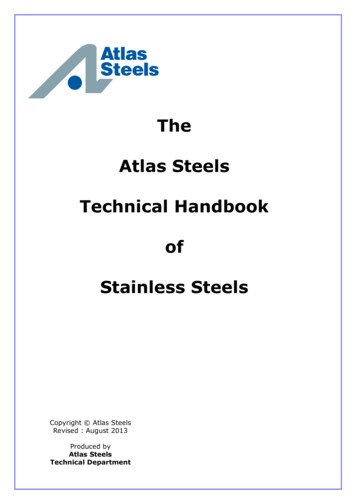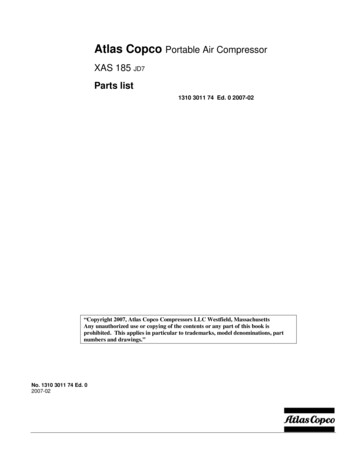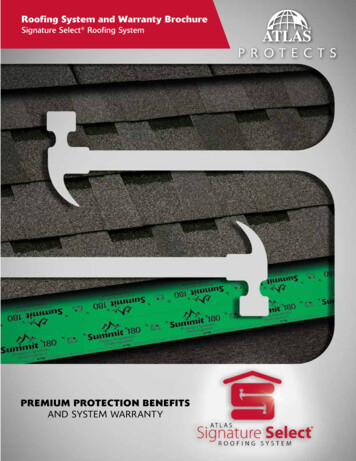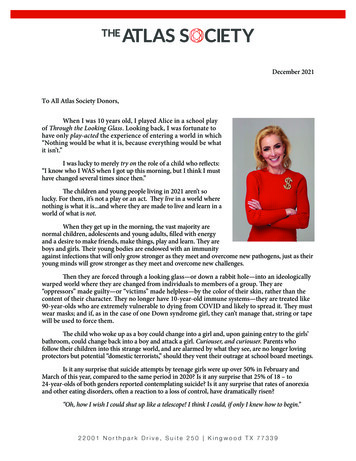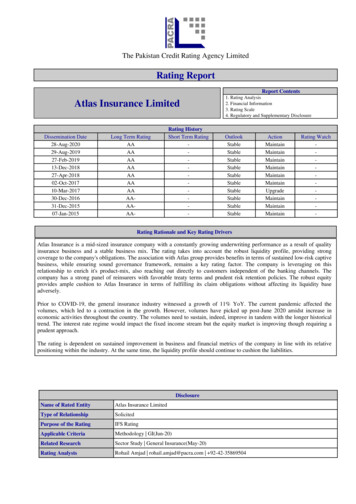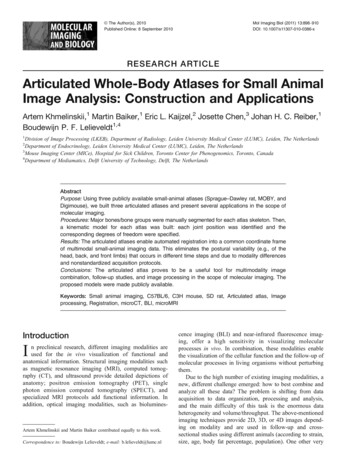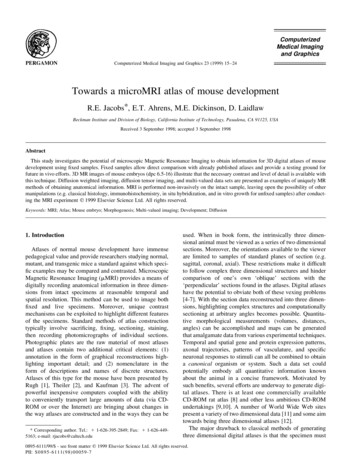
Transcription
CMIG 281ComputerizedMedical Imagingand GraphicsPERGAMONComputerized Medical Imaging and Graphics 23 (1999) 15–24Towards a microMRI atlas of mouse developmentR.E. Jacobs*, E.T. Ahrens, M.E. Dickinson, D. LaidlawBeckman Institute and Division of Biology, California Institute of Technology, Pasadena, CA 91125, USAReceived 3 September 1998; accepted 3 September 1998AbstractThis study investigates the potential of microscopic Magnetic Resonance Imaging to obtain information for 3D digital atlases of mousedevelopment using fixed samples. Fixed samples allow direct comparison with already published atlases and provide a testing ground forfuture in vivo efforts. 3D MR images of mouse embryos (dpc 6.5-16) illustrate that the necessary contrast and level of detail is available withthis technique. Diffusion weighted imaging, diffusion tensor imaging, and multi-valued data sets are presented as examples of uniquely MRmethods of obtaining anatomical information. MRI is performed non-invasively on the intact sample, leaving open the possibility of othermanipulations (e.g. classical histology, immunohistochemistry, in situ hybridization, and in vitro growth for unfixed samples) after conducting the MRI experiment 䉷 1999 Elsevier Science Ltd. All rights reserved.Keywords: MRI; Atlas; Mouse embryo; Morphogenesis; Multi-valued imaging; Development; Diffusion1. IntroductionAtlases of normal mouse development have immensepedagogical value and provide researchers studying normal,mutant, and transgenic mice a standard against which specific examples may be compared and contrasted. MicroscopicMagnetic Resonance Imaging (mMRI) provides a means ofdigitally recording anatomical information in three dimensions from intact specimens at reasonable temporal andspatial resolution. This method can be used to image bothfixed and live specimens. Moreover, unique contrastmechanisms can be exploited to highlight different featuresof the specimens. Standard methods of atlas constructiontypically involve sacrificing, fixing, sectioning, staining,then recording photomicrographs of individual sections.Photographic plates are the raw material of most atlasesand atlases contain two additional critical elements: (1)annotation in the form of graphical reconstructions highlighting important detail; and (2) nomenclature in theform of descriptions and names of discrete structures.Atlases of this type for the mouse have been presented byRugh [1], Theiler [2], and Kaufman [3]. The advent ofpowerful inexpensive computers coupled with the abilityto conveniently transport large amounts of data (via CDROM or over the Internet) are bringing about changes inthe way atlases are constructed and in the ways they can be* Corresponding author. Tel.: 1-626-395-2849; Fax: 1-626-4495163; e-mail: rjacobs@caltech.eduused. When in book form, the intrinsically three dimensional animal must be viewed as a series of two dimensionalsections. Moreover, the orientations available to the viewerare limited to samples of standard planes of section (e.g.sagittal, coronal, axial). These restrictions make it difficultto follow complex three dimensional structures and hindercomparison of one’s own ‘oblique’ sections with the‘perpendicular’ sections found in the atlases. Digital atlaseshave the potential to obviate both of these vexing problems[4-7]. With the section data reconstructed into three dimensions, highlighting complex structures and computationallysectioning at arbitrary angles becomes possible. Quantitative morphological measurements (volumes, distances,angles) can be accomplished and maps can be generatedthat amalgamate data from various experimental techniques.Temporal and spatial gene and protein expression patterns,axonal trajectories, patterns of vasculature, and specificneuronal responses to stimuli can all be combined to obtaina canonical organism or system. Such a data set couldpotentially embody all quantitative information knownabout the animal in a concise framework. Motivated bysuch benefits, several efforts are underway to generate digital atlases. There is at least one commercially availableCD-ROM rat atlas [8] and other less ambitious CD-ROMundertakings [9,10]. A number of World Wide Web sitespresent a variety of two dimensional data [11] and some aimtowards being three dimensional atlases [12].The major drawback to classical methods of generatingthree dimensional digital atlases is that the specimen must0895-6111/99/ - see front matter 䉷 1999 Elsevier Science Ltd. All rights reserved.PII: S0895-611 1(98)00059-7
16R.E. Jacobs et al. / Computerized Medical Imaging and Graphics 23 (1999) 15–24be physically deconstructed from its native three dimensions into a series of two dimensional sets of data, andthen digitally reconstructed back into three dimensions.The reconstruction back into three dimensions is a nontrivial effort because of artifacts generated during histological processing and the computational expense of aligning ahost of individual sections [13–15]. mMRI is a qualitativelydifferent imaging method that offers a convenient meansaround these difficulties. In the MRI experiment the signalis digitized essentially as it is being originally observed.mMR images are conveniently collected in three dimensionsfrom intact samples with sufficient contrast and spatial resolution to identify many anatomical features. For futurework, we note that mMRI is a non-invasive in vivo imagingmethodology making it possible to repeatedly image thesame specimen over time [15–17]. Thus, one has the potential to image an embryo in vivo, then analyze it in vivo or asa fixed specimen, and then directly compare these data sets.This study outlines some examples that point out theadvantages and disadvantages of using mMRI to obtaindata for three dimensional atlases of mouse developmentusing fixed samples. The use of fixed samples will allowdirect comparison with already published atlases andprovide a testing ground for future in vivo efforts. First webriefly discuss mMRI methodology with emphasis on howcontrast arises in the MR image and may be manipulated bythe experimental protocol. Secondly, we present renderingsof 3D MR images of mouse embryos (day post coitum 6.5–16) illustrating the contrast and level of detail available withthis technique. In this context we discuss MR diffusionweighted imaging, diffusion tensor imaging, and multivalued data sets as examples of uniquely MR methods ofobtaining anatomical information [18,19]. Thirdly, weoutline specific shortcomings of mMRI and possibleextensions.2. Methods2.1. MR MicroscopyOne of the principal advantages of MR imaging is itsability to perform three dimensional non-invasive imagingof optically opaque specimens. One of its principal disadvantages is the intrinsically poor signal to noise ratio (SNR)of the recorded signals. This limits the spatial and temporalresolution of the MR image. Physical limits to the spatialresolution obtainable with MRI have been discussed indetail by a number of workers [20–24]. Estimates of thetheoretical limits of resolution in the MR image rangefrom 2 to 0.5 mm [25,26]. The practical spatial resolutionis currently determined by SNR which is often limited bythe amount of time available to acquire the image (i.e. thetemporal resolution). The challenge in MRI microscopy isto optimize the experimental setup (hardware and software)to overcome the poor intrinsic SNR in order to obtain arespectable image in a reasonable amount of time. Thereare a number of ways of recovering this signal loss, including working at high magnetic fields and customizing hardware and software to the samples of interest [15,22]. Thesuccess of these methods is substantiated by MR imagingexperiments with spatial resolutions of 10 mm or less thathave been achieved by several groups working at fieldstrengths ranging from 4.7 to 14 T [16,25,27].2.2. Diffusion MRITypically, contrast in the proton MR image arises fromregional differences in T1, T2, magnetic susceptibility, and/or proton concentration that in turn arise from regionaldifferences in physical, chemical, and structural propertiesof the sample. This is used to great advantage clinicallybecause it offers means of differentiating tissue types. Inaddition, using a voxel-wise measurement of water diffusionrates, MR imaging can be used to gain information abouttissue geometry: whether it is isotropic or anisotropic. Inwhite matter of the central nervous system water diffusionis anisotropic; faster along fibers than perpendicular tothem. Whereas, in gray matter it is essentially isotropic[19]. Anisotropy in the context of diffusion MRI meansthat each image voxel containing white matter has a uniqueset of values for the diffusion rate of water along each spatialdirection. Mathematically, diffusion is described by D, asymmetric 3 3 tensor with six independent values corresponding to diagonal and off-diagonal elements or directions. Diffusion anisotropy can be defined as the ratio ofthe diffusion rates parallel and perpendicular to the fiberorientation. In white matter tracts, the value can reach 2 to3; whereas, in isotropic gray matter it is roughly unity [19,28–30].2.3. MRI ExperimentProton MR imaging was performed at 11.7 T using avertical bore (89 mm) Bruker AMX500 micro-imagingsystem (Bruker Instruments Inc., Billerica, MA). Thissystem utilizes home-built RF probes and a low-noisepreamplifier. An Acustar shielded gradient set (BrukerInstruments Inc., Fremont, CA) provides gradient strengthsup to 290 G/cm. Images were recorded at 4 C. Three dimensional multi-spin echo imaging protocols [22] were utilizedwith one to six echoes being accumulated per excitation.Recycle (TR) and echo (TE) times are noted in figures,but typically TR 800 ms and TE 10 ms to 200 ms.Data matrices were typically 256 128 128 points yielding isotropic volume elements (voxels) of size 15–60 mmdepending on the chosen field of view.Diffusion weighted and diffusion tensor images wereobtained as described by Ahrens et al. [35]. Diffusionweighted images (DWIs) were acquired using a multislice pulsed gradient spin echo imaging protocol [31,32]with d 2 ms and D 7.4 ms, where d and D are thewidth and separation of the diffusion gradient pulses. For
R.E. Jacobs et al. / Computerized Medical Imaging and Graphics 23 (1999) 15–2417Fig. 1. Volume renderings of 3 dimensional MR images of fixed mouse embryos. Embryo age days post coitum are noted. All data were acquired using a 3DFTspin-echo imaging sequence with TR/TE of 800/10 ms for 6.5 dpc, 900/32 ms for 9.5 dpc, 900/32 ms for 10.0 dpc, 900/32 ms for 10.5 dpc, 500/40 ms for11.0 dpc, 500/30 ms for 11.5 dpc, 700/32 ms for 13.0 dpc, 800/30 ms for 13.5 dpc and 500/30 ms for 16.0 dpc sample. Only half the volume data is shown forthe 6.5 dpc and 11.5 dpc; beginning at the central slice so that internal anatomy is evident. Voxels in the 14.0 dpc image are rendered semi-transparent to showinternal anatomy. Orthogonal slice data can be found at tlas.html.the diffusion tensor determination a total of 29 DWIs weremeasured with the same pulse sequence, d , D, but withgradient pulse strengths that varied from 0 to 50 G/cm.The effective diffusion tensor, D, for each voxel was determined using this series of DWIs. The diffusion tensor associated with each image voxel of a DWI satisfies theequation:I I0 e bD1 where I represents voxel intensity, b represents the diffusionweighting; while I0 and the diffusion tensor, D, are unknownfit parameters. The diffusion weighting, b, accounts for boththe diffusion and imaging gradients and was determined bynumerical calculation [32–35]. Baysian probabilistic fittingtechniques were used to solve for I0 and D in a system ofthese equations, one for each DWI.2.4. AnimalsTimed pregnancies between C57BL/6J females andDBA/2J males were used to generate embryos at variousstages. Noon on the day of the vaginal plug is regarded as0.5 days post coitum (dpc). Pregnant females were euthanized with CO2, the embryos were excised and fixed byimmersion in 4% paraformaldehyde for 48 hours at 4 C,then washed several time in Phosphate Buffered Saline(PBS) (Sigma). For imaging, the fixed specimen wasimmersed PBS or magnetite doped agarose (1% agarose inPBS, 0.26 mg Fe/ml). The agarose served to maintain thesmaller specimens in the center of the RF coil and themagnetite lowered the MR signal intensity of the agarose.2.5. VisualizationImage visualization was performed on HP9000/755workstations (Hewlett Packard Inc., Palo Alto, CA) usingin-house volume rendering software and SGI workstations(Silicon Graphics Inc., Mountain View, CA) using VoxelView (Vital Images Inc., Fairfield, IA). Diffusion tensorresults were computed using the HP workstations and inhouse software.3. ResultsSemi-transparent volume renderings of three dimensionalMRI data sets from intact specimens at ten time points areshown in Fig. 1. For the 6.5 and 11.5 day post coitum (dpc)data, rendering begins at a mid-sagittal plane and proceedsbackwards into the page, thus only half the information isdisplayed. For rendering the 14.5 dpc data each voxel wasset to be relatively transparent. Both these manipulationsserve to reveal internal structure in volume images. Forexample, the heart, somites, brancial arches, forminglimbs, and digits are all apparent in the images. In theother renderings all the data is shown, but each voxel isset to be relatively opaque. The information evident in
18R.E. Jacobs et al. / Computerized Medical Imaging and Graphics 23 (1999) 15–24Fig. 2. a. Minimally annotated semi-transparent volume renderings of fixed mouse embryos at 6.5 dpc and 8.5 dpc. Three views of the 8.5 dpc data are shown:left, ventral; middle, side; and right, dorsal. Isotropic voxel resolution is 20 mm in both image, acquired with 3DFT spin echo sequence, TR/TE 800/10 ms.b. Three annotated semi-transparent views of a 14.0 dpc fixed mouse embryo. Note the similar intensities of large nerves (e.g. cranial nerves) and the not yetossified skeletal system (e.g. scapula). Non isotropic voxel size of 27 46 46 mm, image acquired with 3DFT spin echo sequence, TR/TE 800/20 ms. Scalebars represents 500 mm in all three cases.these images is mainly about the surface features of thespecimens. Each of the images in Fig. 1 represents onedata set from each MR imaging experiment. Not shownare 4 to 6 other coincident MRI data sets for each samplethat were recorded with different values of the experimentalparameter TE and offer different contrast.Fig. 2 shows enlarged and annotated views of 6.5, 8.5 and14.5 dpc specimens. In the 6.5 dpc sample, the decidua wasleft intact to investigate the level of contrast betweenembryonic and extra-embryonic tissue at early stages.Three views of the 8.5 dpc sample are shown in whichextra-embryonic tissue has been removed. This specimenhas been captured part way through the turning processthat is characteristic for mammalian embryos [36]. Thissemi-transparent volume rendering clearly reveal structuressuch as the heart, somites, midbrain, hindbrain, and spinalcord. A large number of features are identifiable in the14.5 dpc image, not all of which are labeled nor are visiblein this rendering. The developing skeletal system is stillprimarily cartilaginous at this time [5]. Thus, it is nothypointense as is the case in typical MR images of theadult animal skeletal system [37]. In this image the signalintensity from the skeletal system is similar to that arisingfrom the nervous system (e.g. compare cranial and spinalnerves to the adjacent scapula in the upper sagittal view).Volume renderings and para-sagittal sections from sixdifferent, yet spatially coincident, MRI data sets of a10.5 dpc embryo are shown in Fig. 3. The images wererecorded in a single imaging session. The five images withTE values varying from 10 to 50 ms were recorded during asingle multi-echo acquisition protocol and the diffusionweighted image was recorded immediately following it.Taken together these data sets comprise a single multivalued data set where each voxel has six values associatedwith it. The TE 10 ms image is essentially a proton densityweighted image where contrast is low due to the relativelyuniform water concentration. The longer TE-valued imagesshow increased intensity differences in different parts of theembryo and a decrease in overall SNR with increasing TE.The diffusion weighted image was recorded with diffusiongradients in the anterior-posterior direction causing adecrease in signal from water motion in that direction.Thus, contrast originates from qualitatively differentmechanisms than that obtained in the T2 weighted images.The depiction of multi-valued data in a two or threedimensional format is a formidable problem. There areseveral techniques for reducing the dimensionality of theproblem. One is simply to view the components individuallyas in Fig. 3. Another is to perform a principal componentanalysis or eigenimage filtering methods [38] and view the
R.E. Jacobs et al. / Computerized Medical Imaging and Graphics 23 (1999) 15–2419Fig. 3. Fixed mouse embryo 10.5 dpc represented in a multi-valued 3D MRI data set. Top panel show semi-transparent volume renderings, while bottom panelshows para-sagittal slices through the data. Diffusion weighted image in the upper left was acquired with a 2D version of PGSE sequence with TR/TE 800/30 ms, d 4 ms and D 24 ms, where d and D are the width and separation of the gradient pulses. Gradient strength was 16 G/cm and direction was along thelong axis of the specimen. The remaining 5 images were acquired with a multi-echo SE sequence with the echo times noted of 10 ms through 50 ms. Isotropicvoxel resolution is 40 mm for all images. Diffusion weighted image was recorded immediately after the multi-echo experiment with identical magnitude anddirection of the position encoding gradients. These six data sets are spatially coincident. Each voxel may be thought of as contain six values.
20R.E. Jacobs et al. / Computerized Medical Imaging and Graphics 23 (1999) 15–24Fig. 4. Slices of six-valued mouse embryo magnetic resonance volumeimaging data (a–f). Each image shows one component of the six-valueddata., For panels (a–f), TE 10, 20, 30, 40, 50 and 100 ms, respectively;and TR 1000 ms for the 3D spin-echo MRI acquisition. (g) and (h) showtwo different linear combinations of the images in (a–f). The combinationswere chosen to satisfy goals that would make them particularly effective forvolume-rendering. The first, (g), creates a mask for specimen versussurroundings and the second, (h), contrasts different materials optimally.Both achieve the intensity goals while keeping noise below a specifiedlevel.individual components. A new technique, illustrated in Figs.4 and 5, shows slice and volume images created as linearcombinations of the six spatially coincident volume imagesbased on particular specified goals [39]. The original MRdata were acquired as two multi-echo acquisitions, one ofFig. 5. Volume rendering created from the optimal linear combinationsshown in Fig. 4. The surface of the embryo is well-defined by the maskcombination and the interior materials well distinguished in the cutawayportion of the image.Fig. 6. Multi-slice transverse diffusion weighted images through the brainand spinal cord of the 12.5 dpc mouse embryo whose optical image isshown in the lower panel. Slice locations are noted in the optical image.Each column shows the same slice with the left column being the mostposterior slice. Each row shows a different experimental condition: d–v,diffusion weighting in dorsoventral direction; m–l, diffusion weighting inmediolateral direction; r–c, diffusion weighting in rostrocaudal direction;T2, diffusion gradients set to zero. In all DWIs the gradient strength was32G/cm, d 2 ms and D 7.4 ms. In all 16 slices the thickness was300 mm with in-plane resolution of 20 20 mm and TR/TE 2000/17 ms. Scale bar is 500 mm. The pre-myelinated fiber tracts in the marginalzone (arrowhead) of the spinal cord are hyperintense in the dorsoventral andmediolateral diffusion weighted slices, but not the rostrocaudal diffusionweighted slice.four echoes (TE 10, 20, 30, 40 ms), and one of two echoes(TE 50, 100 ms). Sections through the initial images areshown in Fig. 4(a–f). Weighting factors for each of the sixMR data sets were chosen to make a linear combinationimage that satisfied goals leading to clear, meaningfulvolume renderings. Two linear combinations were created.The first combination was a ‘‘mask’’ value, used as opacityin the rendering process. To begin, a small set of representative points in the images from five different regions ofinterest within the embryo were selected. A combinationof images was then chosen in which one could utilize theblack signal outside the embryo and a constant value insidethe embryo. The best images had sufficient signal-to-noiseratio (SNR) between black and the constant value. A secondcombination was chosen to map different materials toequally spaced intensities with a sufficient contrast-tonoise ratio. Sections through the resulting combinationimages are shown in Fig. 4(g) and (h) and a volume rendering using the combination images in Fig. 5.
R.E. Jacobs et al. / Computerized Medical Imaging and Graphics 23 (1999) 15–24Fig. 7. Diffusion tensor elements (Dij) from the most rostrol slice in Fig. 6.The elements were obtained from a non-linear fit of Eq. (1) using a total of29 diffusion weighted images. Experimental parameters were as for theimages in Fig. 4 with a variety of gradient directions and strengths rangingfrom 0 to 50 G/cm. Scale bar is 500 mm. Diagonal tensor elements revealthe large amount of diffusion anisotropy present in the marginal zone of thespinal cord.Fig. 6 shows diffusion weighted images of a 12.5 dpcmouse embryo with diffusion weighting in each of threemutually perpendicular directions. The four slices wererecorded at the locations shown in the optical image (Fig.6 lower panel). Each column shows the same slice, whereeach image in the column is weighted by diffusion gradientsapplied along the dorsoventral, mediolateral, and rostrocaudal directions. The bottom row shows T2 and proton densityweighted images that were acquired using the same experimental conditions as the diffusion weighted data, except thatthe diffusion gradients were set to zero. Pre-myelinated fibertracts in the marginal zone of the spinal cord are clearlyvisible as hyperintense areas in the dorsoventral and mediolateral diffusion weighted images. With the diffusion gradients applied along the rostrocaudal direction, the entirespinal cord has relatively uniform intensity. To quantifythe water diffusive motion in this sample, the entire effectivediffusion tensor was measured. The results of this measurement are shown in Fig. 7 for the most posterior slice of Fig.6. Differing intensities of the diagonal elements in themarginal zone indicate a significant amount of diffusionalanisotropy. Using MR to obtain diffusion weighted anddiffusion tensor images offers a means to access the characteristics of water diffusion on a voxel by voxel basis.Therefore, we can obtain information about the microstructure of the underlying tissue.4. DiscussionThe goal of the present work is to assess the usefulness ofmMRI in constructing digital atlases of mouse development.21Such atlases require three dimensional data recorded at anumber of time points during development. The data musthave sufficient spatial resolution, SNR, and contrast toenable different tissues and organs to be distinguished. Infixed samples where motion is not a consideration, theattainable spatial resolution is largely determined by thedesired SNR in the final image which is determined bythe experiment time. Thus, there is a definite trade-offbetween resolution, SNR, and experiment time. Experimenttimes of 12–25 hours afford the quite reasonable SNR seenin Figs. 1–7. Spatial resolution in these MR images is somewhat coarser than that employed in the atlases of Theiler [2],and Kaufman [3]; ranging from 15 mm in the youngerembryos to 60 mm in the oldest specimens. Nevertheless,many anatomical details are evident at 15mm resolution inthe 8.5 dpc specimen of Fig. 2(a) (e.g. individual somites)and at 30 mm resolution in the 14 dpc image of Fig. 2(b)(e.g. structures in the eye). If it proves necessary, spatialresolution of 15 mm is experimentally attainable for allthe sample sizes imaged in this study, but at the expenseof longer experiment times and significantly larger data sets.In a physically sectioned embryo, tissue types are typically distinguished by histological staining methods. In theMR images presented in this work no extrinsic stains havebeen added to the specimens. Instead, the ‘stains’ reside inthe intrinsic physical nature of the tissues that modulate theMR signal. T2 and diffusion weighting are two ways of‘developing’ these intrinsic ‘stains’ that accentuate thedifferences in the properties of the different parts ofthe sample. The labor required to go from fixed sample tothe 3D digital MR image is minimal when compared to theanalogous histological process. Furthermore, MR contrastagents offer a potential means to alter the MR image intensity in particular parts of the sample by the addition ofexogenous agents [40,41]. MR contrast agents are moreobviously analogous to the stains employed in histologicallabeling as they are exogenous compounds added to thepreparation in order to differentiate one part of the specimenfrom another. Strategies involving such contrast agents arecurrently being pursued to determine specificity for differentregions of the embryo [10,42–44].In some cases the intensity level of one tissue type in asingle image may be quite similar to a distinctly differenttissue type (e.g. portions of the skeletal system and nervoussystem seen in Fig. 2(b)). Although a priori knowledge ofthe expected location and shape of the different tissues mayallow their discrimination, different experimental parameters may provide another image in which the tissues ofinterest have significantly different intensities. Determiningthe set of experimental parameters that will provide theoptimal image is not a trivial matter due to the large numberof parameters that effect the image intensity and will dependstrongly on the goals of the viewer. This difficulty iscompounded by the rapid cell differentiation and morphological changes that take place early in development thatcan be accompanied by local changes in T1, T2, D, and water
22R.E. Jacobs et al. / Computerized Medical Imaging and Graphics 23 (1999) 15–24concentration. Thus, an optimal set of experimentalparameters for imaging a 8.5 dpc specimen may be differentfrom the optimal set for imaging a 16.5 dpc specimen. Wehave adopted the approach of recording multiple spatiallycoincident data sets, then choosing the most appropriate oneand or mathematically combining them to take advantage ofall the information contained in the multi-valued data. Fig. 3shows representations of a multi-valued MRI data setdemonstrating that even relatively minor changes in experimental parameters (i.e. TE variation from 10 to 50 ms) hassignificant effects on MR image contrast. Moreover, thediffusion weighted images (Fig. 6) provide contrast of afundamentally different variety: signal is suppressed inregions with the most rapid diffusion along the anterior–posterior direction. Analysis of multi-valued data sets(Figs. 4 and 5) will aid in discrimination of tissues thatdisplay similar intensities at a single set of experimentalparameters.In an atlas of development it is essential to include information about the characteristics of structures, tissues,organs, as well as information about their sizes, shapes,and locations. The variety of physical mechanisms thatgive rise to contrast in the MR image and the versatilityof the technique make it possible to access local propertiesof water that are modulated by the underlying characteristics of the tissues. For example, fiber tracts are stronglyanisotropic, having roughly cylindrical symmetry. Waterdiffusion in this anisotropic environment is also anisotropic:diffusion along the fiber bundle is relatively rapid comparedto the rates perpendicular to the bundle direction. In the caseof injured or diseased fiber tracts the local environment canbecome less anisotropic and water diffusion becomes moreisotropic [35]. In Fig. 6 diffusion weighted MR imaging isused to delineate the initial phases of the formation of fibertracts in the marginal zone of the mouse embryo spinal cord.The strongly oriented, but not yet myelinated, tracts in themarginal zone appear bright in DWIs when the diffusiongradients are perpendicular to the tract direction (dorsoventral and mediolateral). This is because the effectivediffusion coefficient perpendicular to the tract direction issignificantly smaller than that parallel to the tract directionor that in the surrounding tissue. Thus, signal strength in themarginal zone is less effected by these diffusion sensitizinggradients. The diffusion tensor image confirms that waterdiffusion in the marginal zone where fibers mostly alignalong the length of the spinal cord (Dzz direction) is significantly more rapid than in either perpendicular direction (Dxxand Dyy components). Because the images showing diffusional anisotropy are spatially coincident with the anatomical images, this information can be directly overlaid onto adigital atlas.As pointed out by Kaufman & others [4–6,45–47], twoimportant utilities of a 3D digital atlas are the ability todelineate anatomical domains on a voxel-by-voxel basis(i.e. ‘‘paint in’’ structures) and to overlay informationfrom other sources. Gene expression domains, metabolicactivity, cell lineage, and any other information whosespatial and temporal distribution is known could b
work, we note that mMRI is a non-invasive in vivo imaging methodology making it possible to repeatedly image the same specimen over time [15-17]. Thus, one has the poten-tial to image an embryo in vivo, then analyze it in vivo or as a fixed specimen, and then directly compare these data sets. This study outlines some examples that point out the
